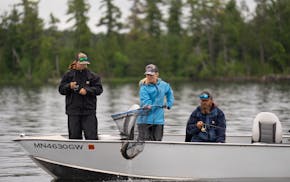Always an Arctic Cat lover, Tom Rowland, who owns Thomas Sno Sports in Ogilvie, Minn., with his wife, Renae, is still mulling the latest news from northwest Minnesota.
Textron Inc., owner of Arctic Cat of Thief River Falls since 2017, said recently it was indefinitely suspending production of its snowmobiles, ATVs and side-by-sides, and possibly looking for a buyer.
"When Arctic Cat first announced a pause in production in November, it wasn't that unexpected,'' Rowland said. "Textron would rather not build machines that dealers can't sell because of excess inventory or too little snow. But this latest announcement, that the plant is shutting down and the company might be sold, was a surprise.''
Rowland was just 15 when he bought his first snowmobile.
Twice his dad raced in the Winnipeg-to-St. Paul back breaker that, years ago, was part of the St. Paul Winter Carnival.
And beginning in the 1960s, his parents were selling and repairing Arctic Cats in a shop on the outskirts of Ogilvie, about 80 miles from the Twin Cities.
So snowmobiles are in his blood.
"Even as a kid I liked wrenching on them, riding them and reading everything I could about them,'' he said.
It was a natural fit, then, when Rowland became an Arctic Cat dealer in 1993, establishing Thomas Sno Sports on the same central Minnesota property where his parents had established their business decades earlier.
The most recent Arctic Cat news was particularly unwelcome, Rowland said, because — unlike dealers who sell several brands of ATVs and snowmobiles — he carries Arctic Cat products exclusively.
This includes Tracker four-wheelers and side-by-sides, which Arctic Cat builds for sale by his and similar size dealerships, as well as Cabela's.
Rowland knows firsthand that snowmobiles aren't the go-to wintertime recreation option they once were. Intermittent snowless winters have hurt sales. The machines can be expensive. And many consumers choose ATVs, which can be used year-round, rather than snowmobiles.
Only 55,000 ATVs, for example, were registered in Minnesota in 1993, when Rowland started his dealership. By 2023, that number had rocketed to 350,000.
By comparison, Minnesota snowmobile registrations peaked at almost 298,000 in 2001 before dropping to 183,000 this year.
Rowland has survived by adapting.
"From the first year we started our Arctic Cat dealership, in 1993, to 1996, we sold only snowmobiles,'' he said. "Then we also started selling ATVs. The first year we sold only four or five. But 10 years later we were selling a couple hundred Arctic Cat ATVs a year.''
Rowland got lucky, he said, in the early 2000s when he attended a presentation by a local newspaperman about the business potential of the internet.
"He talked about what it might be like for us to have a website, and he later built our first website,'' Rowland said. "Without that meeting, I don't know when I would have been exposed to the importance of online sales.''
Today, Rowland sells snowmobile and ATV parts nationwide and, to a lesser extent, worldwide.
Beguiled as he is with snowmobiles, Rowland is even more fascinated by the adventures they enable. That's one reason he's collected a museum's worth of vintage Arctic Cats, more than 40 of which are displayed in his Ogilvie showroom.
"I'm most interested in sleds that tell a story,'' he said. "I might restore an early, experimental model for example. Or a prototype. I even have an Arctic Cat sled that one of the 'old guys' rode from Minnesota to Alaska last year. If I'm going to display a sled, it's got to have a connection to the past. I love hearing the stories.''
In fact, Rowland and I first connected a few weeks ago when he wrote to me saying he was considering refurbishing a 1991 Arctic Cat long track that he believed had once belonged to me.
In a subsequent conversation, I told Rowland my history with snowmobiles dated to when I was a kid in the Upper Peninsula of Michigan. My Boy Scout troop leader at the time owned two Ski-Doos that we used on winter camping trips.
"That's when I first learned how difficult it is to dig a snowmobile out of deep snow,'' I said.
My dad later bought a Sno-Jet, a Canadian built machine, which we sometimes used just to extricate ourselves from our driveway. And when I lived in Ely, some friends and I would run sleds up the Moose Lake chain of lakes to Newfound and Sucker lakes (this isn't allowed anymore), towing skis and packs in sleds behind the snowmobiles. Parking the snowmobiles on Sucker Lake, we'd ski into Basswood Lake in the Boundary Waters Canoe Area Wilderness or Burke Lake in Quetico, where we'd camp and fish for a few days.
Skiing back to Sucker Lake, we'd sometimes find our sleds buried in snow, and sometimes not. Either way, it was a great relief when they started — and a relief as well when our trucks similarly fired up at the Moose Lake landing, completing our little adventure.
"When I bought the long track in 1991, I set it up for fishing,'' I told Rowland. "I also towed our boys on a toboggan at a high rate of speed, frightening their mother.''
Some years later I gave the machine to a brother-in-law who lives near Milaca, Minn. From there, somehow, it ended up in Ogilvie.
This past Monday, Rowland was in his shop early, and by 10:30 he had made his first snowmobile sale to a father and son who had driven to Ogilvie from Ely to buy a sled they had seen on his website.
A sign of continued success for his business?
"Arctic Cat will survive,'' he said. "I think if the right group of investors buys it, the brand can emerge as a niche manufacturer of high quality snowmobiles and ATVs. The factory talent is there to do it.
"Either way, with our internet sales, repair business and the machines we have on hand, our business will be OK. We'll see what happens in Thief River Falls, and go from there.''

Anderson: In early June, Minnesota fish are begging to be caught. Won't you help?

Anderson: Tails wagging, DNR officers' dogs find lost people and missing evidence
Anderson: Punish poachers more
Anderson: The Chainsaw Sisters Saloon is gone, but the Echo Trail is still a pathway to possibilities


